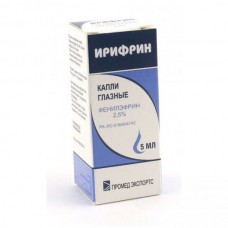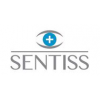Expiration date: 07/2026
The composition and form of issue:
Eye drops 2,5% .1 ml contains Phenylephrine hydrochloride 25 mg
benzalkonium chloride 0.1 mg
Excipients: boric acid, anhydrous sodium metabisulfite disodium edetate sodium phosphate odnosemjannyj sodium phosphate anhydrous disodium, sodium hydroxide and/or hydrochloric acid water for injections
in dark glass bottles with dropper, 5 ml in a cardboard pack 1 bottle.
Description pharmaceutical form:
Transparent solution from colorless to light yellow color.
Description pharmacological action:
Phenylephrine — sympathomimetic. It has a marked alpha-adrenergic activity and when used in normal doses does not have a significant stimulating effect on the Central nervous system.
When applied topically in ophthalmology causes pupil dilation, improves the outflow of intraocular fluid and constricts blood vessels of the conjunctiva.
Phenylephrine has a pronounced stimulatory effect on the postsynaptic alpha-adrenergic receptors, exerts a very weak effect on beta-adrenergic receptors of the heart. The drug has a vasoconstrictor action similar to the action of norepinephrine (noradrenaline), while it is virtually absent chronotropic and inotropic effect on the heart. Vasopressor effect Phenylephrine weaker than that of noradrenaline but is more durable.
After instillation phenylephrine reduces the dilator of the pupil and the smooth muscle of the arterioles of the conjunctiva, thereby causing the pupil to dilate. Pupil size returns to its original state within 4-6 h. since phenylephrine has little effect on the ciliary muscle, mydriasis occurs without cycloplegia.
Phenylephrine easily penetrate the eye tissues, mydriasis occurs within 10-60 min after a single instillation. Mydriasis persists for 4-6 h.
Due to a significant reduction of a dilator of the pupil, 30-45 minutes after instillation in the anterior chamber of the eye can detect particles of pigment from the pigment leaf of the iris. The slurry in chamber moisture must be differentiated from manifestations of uveitis or the presence of blood corpuscles in the anterior chamber.
Indications:
- iridocyclitis (to prevent the rear of adhesions and reduction of exudation from the iris)
- pupil dilation with ophthalmoscopy and other diagnostic procedures necessary to control the state of the posterior segment of the eye
- conduct a provocative test in patients with a narrow profile of the anterior chamber angle and suspected angle-closure glaucoma
- differential diagnosis of the type of injection of the eyeball
- in ophthalmic surgery in the preoperative preparation for pupil dilation (10% solution)
- when performing laser interventions in the fundus and vitreo-retinal surgery
- treatment glycomimetics crises
- treatment of "red eyes syndrome" (2.5% solution) (to reduce redness and irritation of the membranes of the eye).
Contraindications:
- hypersensitivity to the drug
- narrow-angle or angle-closure glaucoma
- old age in the presence of serious disorders of the cardiovascular or cerebrovascular system
- additional pupil dilation during surgical operations in patients with impaired integrity of the eyeball, and also in violation of lesoproduktsii
- hyperthyroidism
- hepatic porphyria
- congenital deficit glukozo-6-fosfatdegidrogenaza
- children up to 12 years and patients with an aneurysm of the arteries (10% solution)
- children with reduced body weight (2.5% solution).
Application of pregnancy and breast-feeding:
Since the action Erythrina in pregnant women and nursing mothers are not well understood, the use of the drug in this category of patients is possible only in case if the expected effect exceeds the risk of possible side effects in the fetus.
Side effects:
Burning sensation (in early use), blurred vision, irritation, discomfort, lacrimation, increased intraocular pressure, reactive miosis (the next day after applying at this time re-instillation drugs can give a less pronounced mydriasis than the day before the effect is often seen in elderly patients).
From the side of cardiovascular system: palpitations, tachycardia, cardiac arrhythmia, including ventricular, arterial hypertension, reflex bradycardia, occlusion of coronary arteries, pulmonary embolism, myocardial infarction (in some cases, when using a 10% solution in elderly people who have cardiovascular disease).
Drug interactions:
Mydriatic effect Phenylephrine enhanced by the local application of atropine. The application of 2.5% or 10% solution of MAO inhibitors, and also within 21 days after their withdrawal should be carried out with caution, because the evolution of systemic adrenergic effects. Vasopressor action of adrenergic agents may potenziruetsa tricyclic antidepressants, propranolol, reserpine, guanetidina, metildopoj and m-holinoblokatorami. The use of a 10% solution Erythrina in combination with systemic use of beta-blockers may lead to severe hypertension. Asiprin can potentiate the inhibition of cardiovascular activity during inhalation anesthesia.
Method of application and dose:
Local.
When performing ophthalmoscopy uses a single instillation of 2.5% solution. Typically, to create mydriasis enough the introduction of 1 drop of 2.5% Erythrina into the conjunctival SAC. Maximal mydriasis is achieved after 15-30 minutes and is maintained at a sufficient level within 1-3 hours, if necessary, the maintenance of mydriasis for a long time, after 1 hour the possible re-instillation.
Adults and children over 12 years of age with insufficient mydriasis, as well as in patients with a rigid iris (pronounced pigmentation) for diagnostic mydriasis may use a 10% solution in the same dosage.
To carry out diagnostic procedures, a single instillation of 2.5% solution used by:
- as a provocative test in patients with a narrow profile of the anterior chamber angle and suspected angle-closure glaucoma. If the difference between the values of intraocular pressure before instillation and after pupil dilation ranges from 3 to 5 mm Hg. article, the provocative test is considered positive
- for the differential diagnosis of the type of injection of eyeball: if 5 minutes after instillation marked narrowing of the vessels of the eyeball, injection is classified as a surface while maintaining the redness of the eyes, one should carefully examine the patient for the presence of iridocyclitis or scleritis, because it indicates the expansion of more deep-lying vessels.
When uveitis of 2.5 or 10% solution is used to prevent the development and rupture of already formed rear adhesions to reduce the exudation in the anterior chamber of the eye. With this purpose one drop of the drug instilled in the conjunctival SAC of the affected eye (eyes) 2-3 times/day.
When glycomimetics crises vasoconstrictor effect Phenylephrine has a hypotensive effect that is more pronounced in 10% solution. For the relief of glaucoma - tsiklicheskikh crises 10% Erimin dug 2-3 times a day.
In the preparation of patients to surgical interventions for 30-60 minutes before surgery to achieve the mydriasis produced a single instillation of 10% solution. After opening the envelopes of the eyeball re-instillation of the drug is not allowed.
Overdose:
Symptoms: possible manifestation of systemic action Phenylephrine.
Treatment: use of alpha-adrenoblokiruyuschim funds, for example from 5 to 10 mg of phentolamine in/in, if necessary, repeatedly.


